














Rising house prices in Kilkenny have once again put homeownership under the spotlight, but a planned change in rural housing policy could offer a lifeline to families keen to build on their own land.
The latest Real Estate Alliance (REA) survey shows that the average second-hand three-bedroom semi in Co Kilkenny has risen by 3.9 per cent in just three months, bringing the typical selling price to €322,803 - up €12,000 since June. Despite a quieter
summer, demand remains strong, particularly for newer, energy-efficient homes.
“There is still high demand for the newer three-bedroomed semi-detached houses,” said Robbie Grace of REA Grace, Callan.
New-build developments are seeing significant activity.
In Thomastown, Phase One of the Fountain Field projectcomprising three-bed semis, duplexes and four-bed houses - has already sold out. Phase Two three-bed semis are now
Kilkenny was the first stop on the Pittsburgh Steelers’ Terrible Towel Tour, which rolled into town on Monday.
Led by former Steelers player and two-time Super Bowl champ Max Starks, the black-and-gold crew are touring Ireland ahead of their historic clash with the Minnesota Vikings at Croke Park this Sunday - the first-ever regular season NFL game played in Ireland.
Starks is travelling the country in a Steelers-branded van, meeting locals, sharing team spirit and handing out the iconic Terrible Towels. Fans can catch the big game free-to-air on Virgin Media on September 28.
priced between €385,000 and €390,000, while in Kilkenny city, Fox Meadows’ new fivebed detached homes start at €645,000, illustrating the premium placed on space and modern facilities.
Against this backdrop, Taoiseach Micheál Martin recently announced a planned “shift” in rural housing policy that could make it easier for families to build on their own land. Speaking at a Fianna Fáil think-in earlier this month, he confirmed a review of plan-
ning guidelines is underway and suggested local authorities could be directed to rezone land near towns and villages, creating more serviced sites for one-off houses.
“There is a shift coming on that,” Martin said, citing advances in wastewater treatment and the soaring cost of housing as key drivers. For many rural families, the policy change could provide an alternative route onto the property ladder, especially if accompanied by measures to make
building more affordable. Campaigners are calling for the reinstatement of the development levy waiver, scrapped earlier this year, to reduce costs for self-builders.
Nationally, REA agents report a surge in landlords exiting the market, with over 40 per cent of sales in Carlow, Kerry, and Waterford attributable to landlords in the past quarter, rising to 60 per cent in Limerick city.
Meanwhile, Kilkenny continues to see strong construction activity, with 140 new housing

Dog owners in Kilkenny are being warned to look out for the signs of lungworm after several recent cases were treated at The Irish Blue Cross Veterinary Clinic. Lungworm is a dangerous parasite that can be fatal if left untreated.
Dogs can catch lungworm from frogs, slugs and snails. Infection can happen while playing outdoors, eating grass, drinking from puddles or coming into contact with
slug or snail slime. Once infected, the parasite travels through the bloodstream and can cause serious illness, including breathing problems, internal bleeding, seizures and, in severe cases, death.
Milder winters and wetter summers mean slugs are surviving for longer, creating a year-round risk for pets.
Laura Mock, Head of Veterinary Services at The Irish Blue Cross, said:
“Lungworm is a silent threat to dogs in Ireland, but the good news is that it’s preventable. Pet owners can protect their dogs by speaking to their vet about the right parasite control and staying alert to the outdoor risks. We also advise against leaving toys and bowls outside where slugs and snails can crawl over them. While some infected dogs may show no signs at first, common symptoms include per-
sistent coughing or breathing difficulties, unexplained bruising or bleeding, low energy, reluctance to exercise and in severe cases, seizures or collapse.”
Veterinary Surgeon Ciara Sweeney said one of the recent cases was Nancy, a 15-year-old Beagle:
“After losing weight very quickly, and developing laboured breathing, Nancy’s concerned owner brought her into our clinic. We did a
blood test and quickly established Nancy had lungworm. Thankfully, we were able to treat her in time, but some dogs weren’t so lucky, so we are appealing to all dog owners to seek immediate veterinary advice if they notice any of the common signs of lungworm.”
For advice on prevention and treatment, contact your local vet or visit www.BlueCross.ie
commencements recorded so far in 2025. However, supply pressures remain, with 40 adults in emergency accommodation during the last week of July - a reminder of the urgency for accessible, affordable housing solutions.
As Kilkenny’s housing market evolves, the combination of strong demand, new-build developments and a potential self-build policy shift could reshape opportunities for local rural families seeking to secure their own home.
Two priests from the Diocese of Damongo, Ghana, are set to begin ministry in the Diocese of Ossory next month.
Fr Felix will be based at St Patrick’s, Kilkenny city, while Fr Paul will serve at nearby St John’s parish. The appointments, confirmed in the St Patrick’s Newsletter, come amid a national shortage of vocations and reflect a growing focus on diversity within the Church. Bishop of Ossory, Dr Niall Coll, told KCLR News the move aims to strengthen local ministry while welcoming international clergy.
Kilkenny Kats memorabilia up for auction
A rare programme from the 1913 All-Ireland hurling final, in which Kilkenny Kats (represented by Mooncoin) defeated Tipperary 2-4 to 1-2 at Jones’ Road, is heading to auction in Castlecomer. The programme, estimated at €2,000–€3,000, includes the full Kilkenny team lineup, adverts, and an eightpage layout with a team photograph on the back cover.
Also up for sale is an historic Bloody Sunday match ticket. Full story: Page 6
Sinn Féin MEP for Ireland South, Kathleen Funchion, has said she is delighted that her party will back Catherine Connolly in her bid to become President of Ireland.
Speaking today, MEP Funchion said:
“Catherine Connolly has been a strong voice for human rights, neutrality, Gaeilge, and for our regions and islands. She will be a President for all of Ireland.
“As a TD for Galway West, Catherine has stood with us on unity, equality, justice, housing, Palestine, disability rights, and ending violence against women.
“She has consistently shown that politics can be about people, principles, and progress.
“She has the independence and integrity needed to represent Ireland on the world stage.
“Our job in Sinn Féin is to get Fianna Fáil and Fine Gael out of government, and to keep them out of the Áras.
“Today’s decision reflects those priorities. We believe Catherine gives us the strongest chance of ensuring the Presidency reflects the values of fairness, equality, and progress. The failed policies of the old parties have no place in Áras an Uachtaráin.
“We can elect a President who will champion a United Ireland, stand up for Ireland’s place in the world as a defend-

er of neutrality and human rights, and speak out for fairness and economic justice.
“Catherine would proudly


Smartphones and smartwatches are fast becoming the preferred way for people in Kilkenny to pay, as contactless transactions continue to rise across Ireland.
New figures from the Banking and Payments Federation Ireland (BPFI) show that contactless payments accounted for 87.9 per cent of all point-of-sale card transactions in the first half of 2025. Of these, 58.2
per cent were made using mobile wallets such as Apple Pay, Google Pay, or Samsung Pay - a jump of almost 20 per cent compared with the same period last year. This means nearly 454 million mobile wallet transactions were made nationwide in the first six months of the year.
In total, 1.6 billion contactless payments, valued at €28.3 billion, were completed across shops, cafés,
Kilkenny’s historic Carnegie Library is set to undergo a major €3.9 million transformation, with funding announced this week under the Government’s Town Centre First Heritage Revival Scheme (THRIVE).
The funding, announced by Minister for Housing, Local Government and Heritage James Browne, has been awarded by the Government of Ireland and the EU. The programme supports local authorities in repurposing heritage sites into cultural, community and tourism spaces.
Carnegie Library on John’s Quay, Kilkenny is set to be transformed into a vibrant cultural hub at the heart of the city and will become “The Stories of Kilkenny - Welcome to Your Past, Present & Future”.
The regeneration will see a refurbishment of the building to improve energy efficiency and accessibility and a redesigned space to the side and rear of the building providing a public meeting space within a sustainable garden.
The building will offer open access to local studies, research and family history resources, alongside exhibitions and heritage programmes
celebrating Kilkenny’s rich history. It’s aim is to actively engage the wider communityschools, adult learners, cultural organisations, migrants and marginalised groups - through workshops, lectures and outreach initiatives. Designed as a welcoming and inclusive space for all, the project reflects the values and principles of the New European Bauhaus.
The Carnegie Library has a rich history in Kilkenny. The original library service evolved from the Kilkenny Circulating Library in the early 1800s, with a reading room located in what is now City Hall. In 1903, Kilkenny Corporation sought funding from Scottish-American philanthropist Andrew Carnegie, who agreed to provide £2,100 toward the establishment of a free public library.
The foundation stone was laid in 1908, and the library officially opened on 3 November 1910, with Lady Desart officiating.
Membership was free for borough residents, and the library housed six functional rooms, including a reading room, reference room, lending department and a ladies’ room.
Gowran Park is set to become a major hub for one of the world’s fastest-growing sports, with plans unveiled this week for a state-of-the-art indoor padel facility on the racecourse and golf club grounds.
Arena Padel, co-founded by former Republic of Ireland goalkeeper Shay Given and brothers Declan and Stuart Fagan, has submitted planning permission for a 22,000 sq. ft complex that will feature five indoor padel courts. The proposed development will also include a sauna, ice bath, changing rooms and an indoor golf simulator, bringing a new layer of sporting and leisure facilities to the iconic
restaurants and other retail outlets in the year to June.
While Dublin continues to lead the country in contactless use, Kilkenny is keeping pace, with local retailers reporting a marked increase in customers paying via phones and watches rather than physical cards or cash. The trend reflects broader changes in consumer behaviour, with speed, convenience and security driving
Men in Kilkenny - and across Ireland - are dying too young of largely preventable causes, according to a new report from Movember.
The Real Face of Men’s Health report reveals that two in five Irish men die before the age of 75, making them 40 per cent more likely to die prematurely than women. Men in the most deprived areas are 150 per cent more likely to die early than those in the least deprived parts of the country - a trend seen in rural areas as well as cities.
The report, developed with the Men’s Health Forum in Ireland and South-East Technological University (SETU), highlights that the five leading causes of years of life lost among Irish menheart disease, stroke, COPD, lung cancer and suicide - cost over €1bn in 2023 alone. More than €700m of that could have been prevented.
Mental health is a key concern. Local GPs told researchers they see men presenting with suicidal thoughts regularly, with most cases involving men aged 18–54. Yet fewer than one in three GPs felt they had a very good understanding of men’s health needs. Stigma, social norms around self-reliance and fear of career impact were identified as major barriers preventing men from seeking help.
the shift
Gillian Byrne, Head of Payments at BPFI, said contactless payments remain “very popular with Irish consumers, accounting for almost nine out of ten point-ofsale card payments.” She noted that smartphones and smartwatches are “the preferred payment device over physical cards for many consumers.” The rise of mobile wallets is mirrored in Kilken-
ny’s shops, restaurants and hospitality businesses, where more customers are tapping and going.
The move away from cash is also clear. Less than half of point-of-sale payments in Ireland were made in cash in 2024, and the trend is expected to continue. For businesses, this means ensuring payment terminals are fully contactless-enabled and able to accept mobile
wallets, meeting the expectations of modern consumers.
For Kilkenny shoppers, the benefits are immediate: faster checkouts, fewer queues, and the convenience of leaving wallets at home. For businesses, embracing contactless and mobile payment options can boost efficiency and customer satisfaction, while keeping up w ith national trends.

The report also highlighted the “ripple effect” of men’s poor health, with 60 per cent of carers - most of them women - reporting a decline in their own mental health.
Sarah Ouellette, Movember’s Country Manager, said the findings should be a wake-up call adding: “We know that with earlier
interventions, screening and gender-responsive healthcare, we can respond to the challenges facing men’s health and bring about positive change.”
Movember is now calling on the Government to invest €10m in a National Men’s Health Action Plan and ensure cross-departmental
support. Barry McGuigan, sporting legend and Movember ambassador said: “The findings demonstrate the urgent need to take meaningful action to address the barriers to men accessing healthcare. The report findings are stark, but it also provides solutions to the issues.”
Kilkenny venue.
Padel - a racket sport often described as a mix between tennis and squash - has been surging in popularity worldwide. “Since retiring, I have found padel to be a brilliant way to keep fit and stay competitive,” said Given. “It’s a sport for all ages and skill levels. We’re looking forward to working with the people of Kilkenny and Carlow to bring this project to life.”
Gowran Park General Manager Eddie Scally welcomed the news, calling the development “another exciting step” for the venue. “The padel centre will really add to our race and golf courses,” he said.
A rare match programme from the 1913 All-Ireland hurling final is heading to auction in Castlecomer, offering collectors a prized piece of Kilkenny GAA history.
The lot is part of Fonsie Mealy Auctioneers’ Rare Books & Collectors’ Sale on Wednesday, October 1. Lot 1208, estimated at €2,000–€3,000, is titled The Earliest Extent All-Ireland Programme G.A.A.: [Hurling 1913] – The All-Ireland Final at Jones Road, Dublin on Sunday November 2, 1913, Tipperary v. Kilkenny.
That final match saw Kilkenny, represented by
Mooncoin, defeat Tipperary, represented by Toomevara, by 2-4 to 1-2 at Jones’ Roadnow better known as Croke Park.
It was a landmark game: the first All-Ireland final played with 15 players a side. With the win, Kilkenny claimed their third consecutive All-Ireland title and their seventh in 10 championship seasons.
The programme itself includes the full Kilkenny team line-up, featuring back-row players Dan Kennedy, Jack Rochford, Pierce Grace, Jack Keoghan, John T. Power, John James Brennan, Matt Gargan, Dick Grace; front-
row players Jim Kelly, Sim Walton, Jack Lannon, Dick “Drug” Walsh (captain), Mick Doyle, Dick Doherty and Dick Doyle. Also included in this lot’s description: “the programme bears adverts, eight pages, with a team-printed photograph on the back cover and original red wrappers.”
Also up for auction is an entrance ticket to Croke Park for what was to become known as Bloody Sunday with a guide price of €3,000 to €4,000. The ticket is described in the guide as: “A memento of the historical retaliations against innocent and unarmed spectators
as a result of Michael Collins’s early morning raids on British agents in Dublin, wherein 14 officers were executed by his squad. It was a dark day in Irish sporting history.”
In the massacre at Croke Park on November 21, 1920, British forces opened fire on a crowd attending a football match between Tipperary and Dublin, killing 14 people. It was an act of retaliation by the crown forces for an IRA operation mounted earlier that day, when the IRA carried out a series of targeted assassinations of British intelligence officers.
By Senator Patricia Stephenson, Social Democrats
This autumn is the first time I will be able to vote for the President of Ireland. Growing up in Northern Ireland - despite being an Irish citizen and holding an Irish passport - I have never held the right to choose my Uachtarán na hÉireann. It did not matter that my mother was from Wexford or how much time I spent in the South. This is the first time I will have a say in electing the person who symbolises so much of what it means to be Irish, both at home and abroad.
It is a privilege to finally have the right to vote, but even more than that it will also be an honour to nominate a candidate that I believe encapsulates the values that the presidency should hold, and Catherine Connolly is just that.
Catherine Connolly represents the best of Irish public life. She has spent her career in politics as a voice for those who are too often ignored or forgotten by the State. In her

time as a TD and as LeasCheann Comhairle of the Dáil, Catherine has shown a moral clarity and a principled independence that are all too rare in politics. She does not flinch from difficult truths.
Her advocacy for survivors of mother and baby homes has been tireless. Catherine stood in the Dáil chamber and insisted that the State face up to its responsibility for one of the darkest chapters in our history. She refused to let survivors’ testimonies be silenced or buried in bureaucracy. She demanded that their dignity and their truth be at the heart of our response. That kind of courage, the willingness to speak uncomfortable truths and to insist that we do better is exactly what we need in an Uachtarán na hÉireann.
Catherine has consistently stood with those most marginalised. Whether it is advocating for mental health reform, housing justice, or the rights of people with disabilities, she has been steadfast in her belief that everyone deserves equality and respect. Her work is not performative, it is grounded in compassion
and persistence.
That same compassion has guided her advocacy for Palestine. Catherine Connolly has been steadfast and consistent in her advocacy on Palestine, calling for human rights and international law to be upheld. She has always demonstrated solidarity with people facing oppression. In a time when global politics can feel cynical, her moral voice has been unwavering.
The presidency is not just about cutting ribbons or delivering warm words. It is about embodying the values of the Irish people. It is about showing moral leadership and Catherine Connolly has spent her career doing just that.
This presidential election is an opportunity to choose someone who will not simply occupy the office but will elevate it. This is why I, alongside my colleagues in the Social Democrats, are nominating and supporting Catherine Connolly for President.
Catherine will be a President who brings empathy and integrity to Áras an Uachtaráin, who listens deeply and who never forgets those on the margins.
As someone voting for the first time, my ballot will carry a special weight. It is a privilege I do not take lightly. I want to use it to endorse a vision of Ireland that is compassionate, inclusive, and courageous. For me, Catherine Connolly represents that vision.

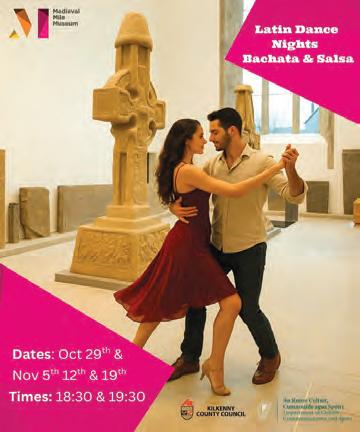
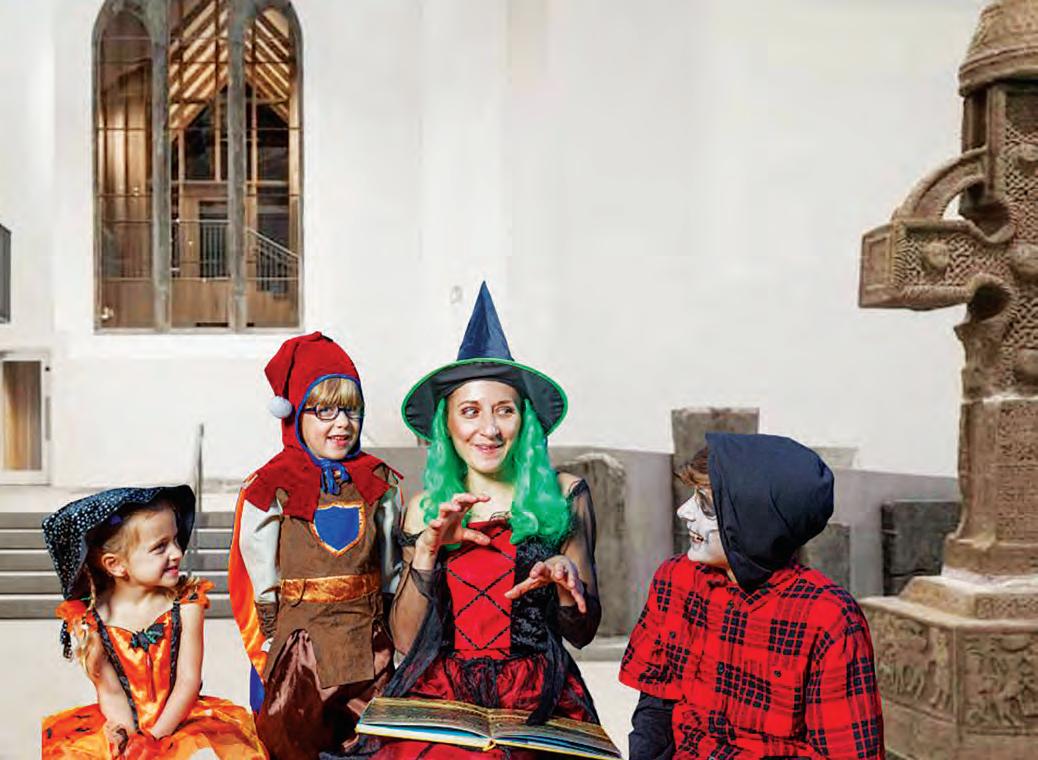
Magic & Mischief at Halloween, Free Entry with Lady Desart Choir, and Latin Dance Nights
spooky surprises, themed décor and spot prizes.
Date: October 28th – 31st
Time: 10:30 & 14:30
Cost: €7.50 per child
Latin Dance Nights
If ghosts and ghouls aren’t your thing, swap broomsticks for dance shoes! On Wednesday nights in November, the Medieval Mile Museum transforms into a dance floor for Latin Dance Nights, presented by The Dance Club Kilkenny with the support of Kilkenny County Council and the Department of Culture, Communications and Sport. Across four Wednesday evenings from 29th October and 5th, 12th &19th November, participants can learn the flowing rhythms of Bachata at 6:30 pm and the highenergy spins of Salsa at 7:30 pm. All levels are welcome, no partner is required, and flexible pricing is available.
Date: October 29th, November 5th, 12th, 19th
Time: 18:30 & 19:30
Cost: €12 per class, €18 both classes, €60 for all 8 classes.
Celebrate Savour
Kilkenny with Free Entry & Live Music
medieval past, and discover the treasures within one of the city’s most atmospheric heritage sites. At 2pm on Sunday 26th October, enjoy a special live performance by the acclaimed Lady Desart Choir. Based right here in medieval Kilkenny, this contemporary SATB choir is made up of 75 singers aged 25 to 82. With a joyful and dynamic repertoire that spans pop, classic rock, folk, musical theatre, and full classical choral pieces, the choir has performed at top festivals and venues across the city.
Savour Kilkenny returns from 24th to 27th October 2025, transforming the city into a vibrant celebration of food, flavour and the Irish feast of Samhain. Set against the majestic backdrop of Kilkenny Castle, the festival features over 100 market stalls, free cookery demos, street food, children’s entertainment, and special dining events across the city. With over 68,000 visitors in 2024, this year’s festival promises even more to savour.
Magic & Mischief on the Mile
Step into a world of enchantment, folklore and frightful
The Medieval Mile Museum has announced an exciting line-up of events for Autumn, inviting the community and visitors alike to experience history, culture and celebration in the heart of Kilkenny.
fun this Halloween with Magic & Mischief at the Medieval Mile Museum. Designed for families with children aged 4 to 14, this immersive experience includes spooky storytelling with The Grim Chronicler, hands-on
potion-making workshops, and a trick-or-treat scavenger hunt through the museum’s shadowy corners. Delivered in collaboration with Home of Halloween and Kilkenny Tourism, each 60–75-minute session is packed with
To celebrate this year’s Savour Kilkenny Festival, the Medieval Mile Museum is opening its doors to the local community completely FREE of charge for one special day. Enjoy free access to the museum throughout the day, explore Kilkenny’s rich
Whether you’re visiting for the first time or returning with friends and family, this is a wonderful opportunity to enjoy the museum in celebration of one of Kilkenny’s most vibrant weekends. No booking required, just drop in and enjoy.
Date: Sunday 26th October
Time: Open From 11am. Lady Desart Choir at 2pm Cost: FREE Entry





Marianne Heron
The assassination of right wing commentator Charlie Kirk was described by Utah’s governor Spencer Cox as ‘A watershed moment.’ His words came as a warning to stop, take heed and realise that cataclysmic change is rapidly becoming irreversible.
Like Malcom Gladwell’s ‘Tipping Point’, ideas can be like a virus which infect the way we think about the world and can push us across a threshold from which there is no going back. Tyler Robinson killed Kirk with a shot to the head because he didn’t agree with his views. Although Robinson acted alone President Trump has responded with a crack- down on left wing organisations. Now it seems anything goes, accountability and humanity no longer feature in the rule book.
An extreme othering, which allows people to engage in threats, violence and incitement are becoming the norm
in society. Here, it’s in the threats to Simon Harris and his family, in the racial attacks on immigrant workers and in the rising tide of domestic violence against women. It’s there in the rise of right wing populism throughout Europe in political parties like Alternative fur Deutschland (AFD). Anything goes in war: in Putin’s war on Ukraine, elderly folk were killed as they queued for their pensions in the ongoing rain of Russian bombs and drones. Netanyahu talks of exterminating Palestinians (a word normally used in pest control) if they don’t move from Gaza City. The war, where over 64,000 Palestinians have been slain, is intensifying despite the UN’s finding last week that Israel is guilty of genocide.
Professor Johan Dornschneider-Elkink at the School of Politics and International Relations UCD, doesn’t see the shooting as a watershed.”
It’s more an indication of how extreme the level of polarisation has become. This has an effect on young people embedded in social networks, where ideas get emphasizes and exaggerated with an echo chamber effect. “
Social media, despite its benefits, creates new opportunities for extremists in communication, mobilisation and recruitment, while algorithms influence, we think, “It’s certainly a factor in the change, “confirms Professor Elkink. ”Lack of dialogue is one of the problems There is very little debate. One of those did was Charlie Kirk, he went out and talked.” Dialogue might help, what else might stem polarisation and chaos? Overcoming our inability to work together too, according to MIT Professor Sinan Aral, author of ‘The Hype Machine.’ “The collective action problem lies at the heart of many of today’s most pressing global challenges. Address-

ing climate change requires large numbers of people (and businesses) to co-operate to reduce their carbon footprints.”
Think of how the EU has acted too little too late to reign in Israel’s genocide in Gaza. There is a strong connection between unresolved problems, divided society and conflict.
“Silence fuels conflict; dialogue is humanity’s last defence
Unless it is managed, conflict can readily erupt causing polarisation, violence and even war. There has to be a willingness by both sides to find resolution. “If there are deeper underlying divisions, we should never underestimate them. If conflicts can be identified early enough and resolved locally, a meltdown might be prevented,” writes conflict analyst Jan van Aken in his book ‘How Wars End.’
Not hard to find underlying divisions here: the absence of affordable housing and accommodation for young people, the need for integration and education around immigrants, the runaway cost of living, where the underlying causes remain unchallenged and the need for effective programmes to tackle radicalisation.
Researching what can be done about the state of the world? Aoife Gallagher research analyst and author
of Web of Lies came up with a list which included social media regulation, media literacy, better critical thinking, better communication and understanding why people fall for extreme theories. While leading intellectual Noam Chomsky’s list for moves towards a better society include one where, “Decisions are in the hands of an engaged and informed public… a fading of national boundaries, an increasingly global system based on mutual support, production for use rather than profit and concern for species survival.” Food for thought. The run up to the Presidential elections could be an ideal opportunity for dialogue about the kind of society we want to have in Ireland and for the successful candidate to continue engaging in debate and encouraging progress towards a better more caring world. Or as Cox put it, ”Log off, touch grass and hug a family member.”

Thinning hair is an extremely distressing thing at any stage of our lives and unfortunately it seems to be a common problem post menopause. As if we haven’t had enough to deal with throughout the menopausal journey. Many women that I have spoken with about hair loss have told me that they had perfectly healthy hair and this is a sudden and upsetting change for them.
There are a couple of reasons why this might be happening. Estrogen and progesterone play a role in the hair growth phase and drops in these hormone levels may impact how fast your hair grows. A rise in the male hormone testosterone can result in your hair growing back thinner or may stop it growing altogether.
Nutritional deficiencies including Iron, Vitamin D, B vitamins and inadequate protein can impact on hair quality. Stress can also have a negative impact as it increases inflammation and reduces how well we absorb nutrients from the food we eat.

Protein is important for healthy hair growth. Include meat, fish, eggs, Greek yoghurt, pulses, lentils, and nuts. Take a protein powder if you need extra, this can be added into yoghurt, juice, or smoothies.
Changes in thyroid hormones can affect hair growth. It would be a good idea to get a blood test to check your thyroid function. Sluggish circulation to the scalp can be an issue. Daily gentle massage to the scalp with Rosemary hair tonic may help improve circulation. Avoid using tight hair bands, hair sprays, or hair colours that are harsh. Supplements may help. I have written about New Nordic Hair Volume before
and customers have had some excellent results. I was delighted when I saw that New Nordic have brought out a new and improved clinically documented formulation to support Post Menopause Hair Loss. It contains a lovely blend including Annurca apple extract– a natural source of procyanidin B2 – alongside key nutrients that support healthy hair and nails. B-Vitamins to help regulate hormonal activity. It contains Biotin now at an increased level from 450ug to 3,000ug. And Horsetail extract—a natural source of silica, often used to strengthen hair. I love this improved blend. I know it may not be the perfect answer for all of you, but it will be worth a try. I hope it helps.
Coláiste na Rinne is delighted to announce the launch of an exciting new Irish Camp taking place from Tuesday, June 2nd to Saturday, June 6th, 2026, hosted on the SETU campus in Waterford City, with a further camp planned from Monday July 6th to Friday July 10th 2026. This five-day immersive camp is designed for young people who wish to strengthen their Irish in a fun, engaging, and supportive environment. Building on Coláiste na Rinne’s proud tradition of Irish-language education the programme will combine classroom-based learning on the Cork Road Campus with sports and games through Irish at the SETU Arena.
As part of the camp, participants will also enjoy a surfing lesson through Irish with Freedom Surf School, Tramore. This unique experience blends sport, adventure, and language learning, offering students the chance to practice their Gaeilge in an energetic, realworld setting.
Speaking about the launch, Coláiste na Rinne’s Director Críostóir Ó Faoláin said: “We are thrilled to bring the richness of the Irish language into the heart of Waterford City in summer 2026. The camp will not only strengthen students’ confidence in Gaeilge but also show them how the language can be lived, spoken, and enjoyed through fun activities like surfing.”
The camp is open to students aged 10 to 15 and places are limited.
For more information and to register, please visit www.anrinn.com or contact the office directly at eolas@anrinn.com / 058 46128.




Internationally renowned art collective, Luxmuralis, will make its Irish debut in Kilkenny this December with Starlight, a 35-minute immersive experience of light, sound, and fine-art projection. The large-scale installation running from 14 to 21 December is the highlight of Kilkenny County Council's Yulefest Kilkenny celebrations this winter. For eight
nights, Starlight will transform the 800-year-old interior of St Canice's Cathedral into a vast canvas of moving light projections and cinematic soundscapes. Described as the 'stained glass windows of our time', as visitors enter the immersive space within the cathedral, they will be guided through an emotional story arc that brings home the meaning of Christmas. The story unfolds
through a series of fine art projections and bespoke accompanying compositions culminating in a powerful retelling of the Nativity story. Organisers say the show will offer Irish audiences a new way to experience the spirit of Christmas. "We're excited to share this extraordinary immersive experience. Something completely new for Ireland," Marian Flannery, Director of Yulefest
Kilkenny, said. "Starlight offers audiences a unique way to rediscover the magic of Christmas, made even more special against the centuriesold walls of St Canice's Cathedral."
Luxmuralis (Latin for light mural) is an internationally renowned artistic collaboration between sculptor Peter Walker and composer David Harper. The collective has presented artwork in some

of the world's most iconic locations, including St. Paul's Cathedral in London, Oxford University, the Limburg Dom in Germany, and The Tower of London. Their work has been seen by over 1.2 million people in the UK, throughout Europe and the United States.
Peter Walker, Luxmuralis' Artistic Director, is pleased to bring the experience to Ireland. "We are delighted to be bringing Luxmuralis to Ireland for the very first time and debuting the Starlight light and sound installation in Kilkenny. It is wonderful to be bringing this immersive artwork to St Canice's Cathedral, something audiences in Ireland have never experienced before. Kilkenny provides the perfect backdrop for this celebration of light, hope and wonder, and we cannot wait to share it in Ireland."
Dean of St Canice’s Ca-
thedral, the very Reverend, Stephen Farrell, added,
“I’m absolutely thrilled that St Canice’s Cathedral is going to host Starlight by Luxmuralis this December. Our historic 800-year-old building has seen so much change. To have such a new, state-ofthe-art art form telling a story that is ancient and timeless really speaks to what we’re about in the Cathedral. I hope that people from across Kilkenny and beyond come and spend some time in a totally immersive light and soundscape.”
Kilkenny Yulefest is the city's programme of Christmas events, which includes markets, concerts, and family activities organised by Kilkenny County Council. St Canice's Cathedral and Round Tower is a focal point in the festivities as it becomes the stage for Luxmuralis; 'art on an epic scale'.
Carlow Little Theatre Society have announced a busy autumn drama schedule to close out the year, including a One-Act Season in early October, taking a play to the All-Ireland One-Act festival circuit, performing the renowned play Gaslight in the Visual on Oct 16th to 19th, an 80th anniversary, and the launch of a long awaited book to commemorate the society’s rich and varied history.
The season kicks off with the society’s Autumn OneAct series at the George Bernard Shaw theatre in Visual, Carlow, on Wednesday 1st and Thursday 2nd October. Both evenings promise lots of drama and comedy, with two plays on offer.
Taking to the stage will be
The Lithium Waltz writer Barry McKinley, which will also be Carlow Little Theatre's entry to the 2025 All-Ireland One Act festival circuit, performing at six festivals around the country. This comedy farce, set in an American psychiatric hospital, and featuring hilarious lines and antics from its cast of colourful characters, was a crowd favourite when previously performed by the society in 2010, when it reached the All-Ireland
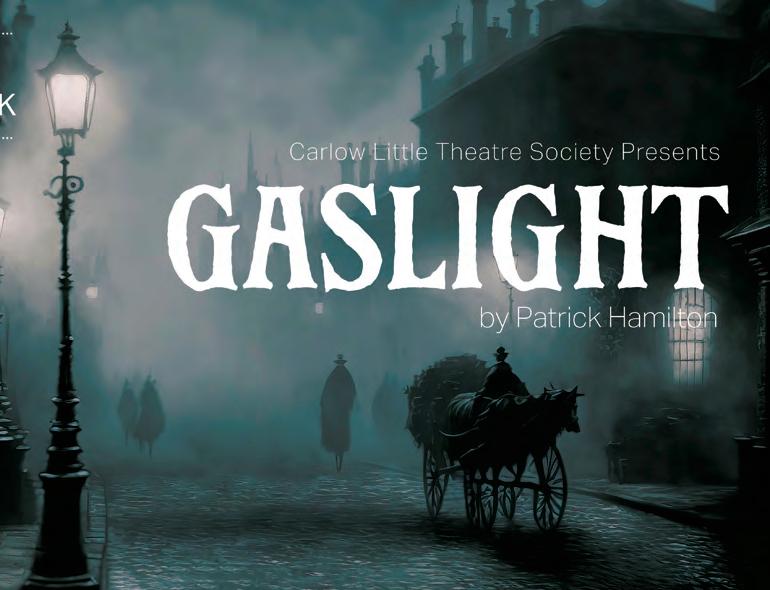
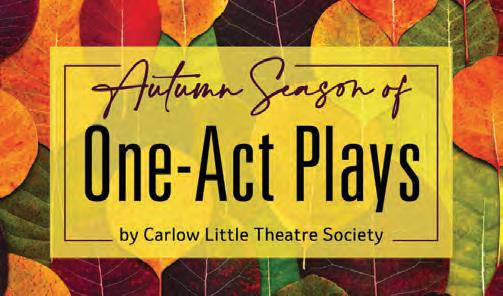
The society returns to George Bernard Shaw theatre just over two weeks later with Patrick Hamilton's acclaimed psychological thriller

by Brandon
a family of four

purgatory and must resolve their collective and individuation issues before being allowed to ‘pass on’.
Performances start at 8pm, with seats priced at €20 and €18 (including booking fee).
Tickets are available from the box office (059 917 2400 | boxoffice@visualcarlow.ie) or via www.visualcarlow.ie
Gaslight, our season’s headline full-length production, which runs from Thursday 16th to Sunday 19th October.
Gaslight is set in fog-bound London in 1880, at the upper middleclass home of Jack Manningham and his wife Bella. Hamilton's play is a twisting tale of a marriage based on deceit and trickery. Another dark evening in a house with a secret history is interrupted by the unexpected arrival of Detective Rough and with it,
the Manninghams' lives are forever changed. The play was the origin of the term ‘gaslighting’ which is the psychological manipulation of someone into questioning their perception of reality, memory or sanity.
Carlow Little Theatre will be having a Benefit Night on the opening night of the play, Thursday October 16th, for Amber Women's Refuge, the specialist domestic abuse organisation, who provide support and refuge services to women in Kilkenny and Carlow.
Gaslight will be directed by Mark Cradock and is presented by arrangement with Concord Theatricals Ltd. on behalf of Samuel French Ltd.
Booking details can be found via www.visualcarlow.ie

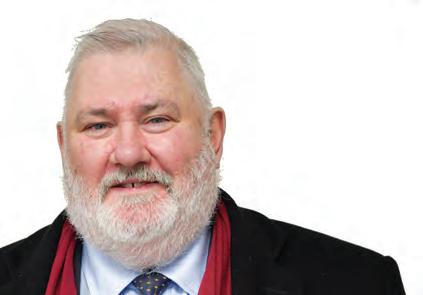
As we gear up for Budget 2026 on October 7, the government faces a tricky tightrope walk as it tries to support the vulnerable while avoiding overheating an already bubbling economy.
It is time to prioritize smart, sustainable changes over flashy giveaways. We’ve enjoyed years of lump-sum payments, tax cuts, and welfare hikes amid crises like Covid and the Ukraine war. Experts have long been sounding alarms that continuing this loose fiscal stance could spell trouble.
The average families juggling rising costs deserve a budget that’s prudent, not populist. Let’s start with social welfare, where inconsistencies are deterring jobseekers from re-entering the workforce.
The Tax Strategy Group, in its pre-budget report, highlights how means-tested thresholds, those portions of income ignored when calculating entitlements, haven’t kept pace with the national minimum wage or earnings. This creates

a ‘penal approach,’ as the group calls it, where picking up extra or part-time shifts can slash benefits, leaving people who want to work worse off.
Especially timely now, with a proposed 65-cent minimum wage increase to €14.15 on the table (though the government may settle lower), the group recommends annually aligning thresholds with wages to motivate work without penalty, thereby aligning with Ireland’s goal of inclusive growth.
Tánaiste Simon Harris has
floated skipping increases to jobseekers’ allowances altogether. He is arguing for bigger increases to pensions and disability payments instead. This makes sense in a full-employment economy, but it risks alienating those on the margins. This comes amid reports that a proposed €12 hike in weekly welfare payments reportedly facing rejection, pushing ministers to rethink resource allocation. This targeted approach extends to the broader budget, where expectations are tempered. Finance Min-
ister Paschal Donohoe and Public Expenditure Minister Jack Chambers have ruled out repeating last year’s bonanza, no €125 energy credits, no double child benefits, and no more once-off payments like the €400 boosts to schemes such as Working Family Payment or Living Alone Increase.
The much-touted two-tier Child Benefit, potentially worth €285 for lower-income families, won’t materialize this year either. Donohoe told RTÉ it’s under review but requires a “complete rejig”
to ensure no one loses out.
Instead, focus shifts to infrastructure, housing, and public services, with VAT tweaks for hospitality eating into funds. Chambers couldn’t quantify household gains but emphasized improving daily life through social protection and investments.
Fair enough, especially given stark warnings from the Economic and Social Research Institute (ESRI), Central Bank, and Irish Fiscal Advisory Council (IFAC). The proposed €9.4 billion package risks adding “unnecessary stimulus” to an economy near full capacity, stated the Central Bank, which upgraded 2025 growth to 2.9% but forecasts slowdowns ahead due to trade fragmentation and US tariffs.
ESRI’s Alan Barrett urged “sound fiscal management,” noting recent spending overruns topping €2.5 billion and a “procyclical policy” that fuels overheating, not just inflation, but capacity strains hampering housing targets.
IFAC’s Seamus Coffey
echoed this, calling for a “more modest” package since spending outpaces sustainable growth. The Central Bank warns we can’t sustain this without tax hikes or infrastructure cuts, highlighting vulnerability from windfall corporate taxes reliant on a few multinationals amid global shifts.
History, like the 2008 crash, reminds us how quickly things can unravel. The government should heed these calls. While some argue for bolder spending amid cost-of-living pressures, the risks of overheating outweigh the short-term gains.
Reform welfare thresholds to encourage work. Target hikes to pensioners and people with disabilities. Broaden the tax base for longterm stability. And no more election-year splurges. We need to build resilience, families need reliable support, not boom-and-bust cycles.
john@ellisfinancial.ie 086 8362633
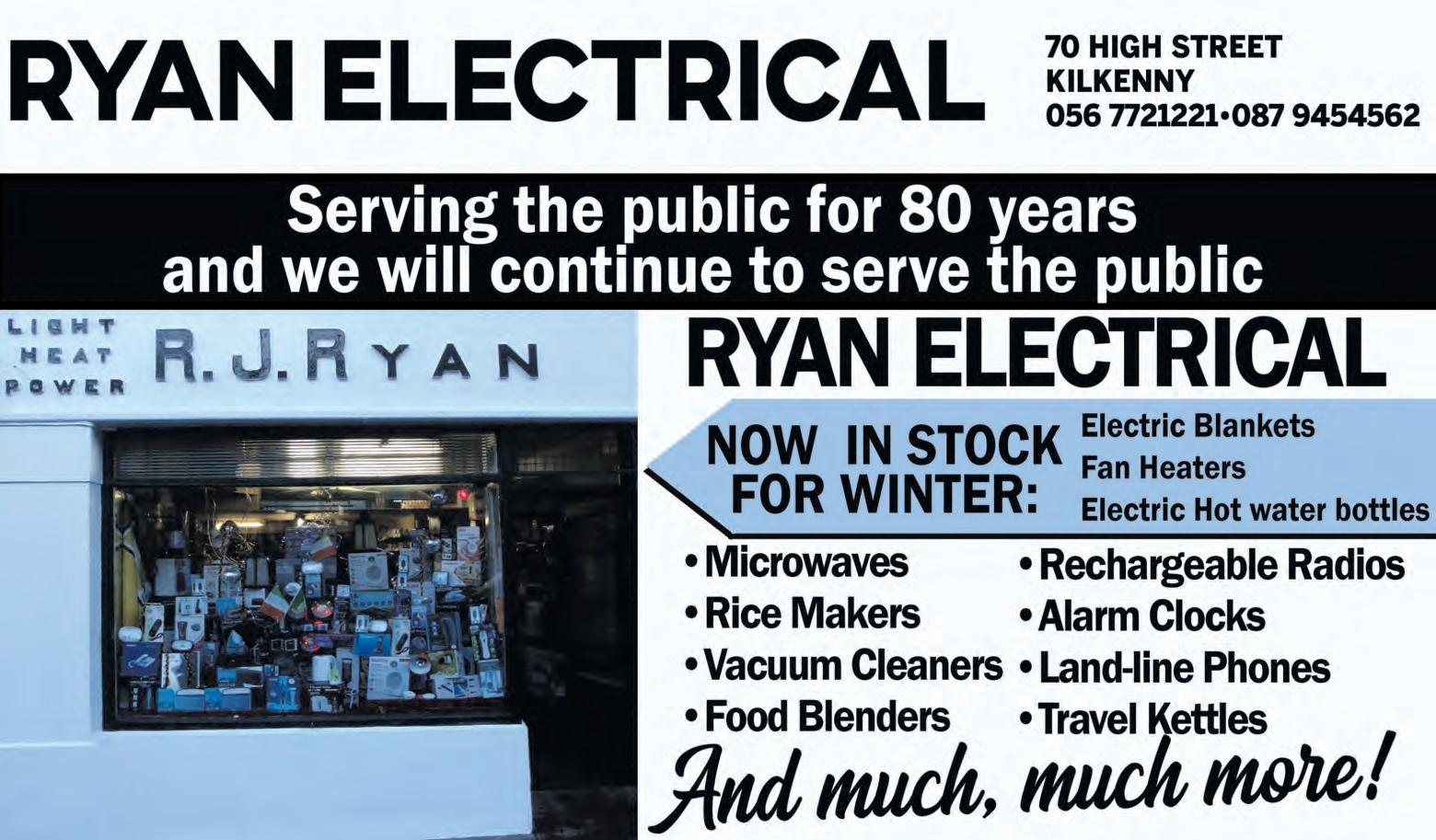


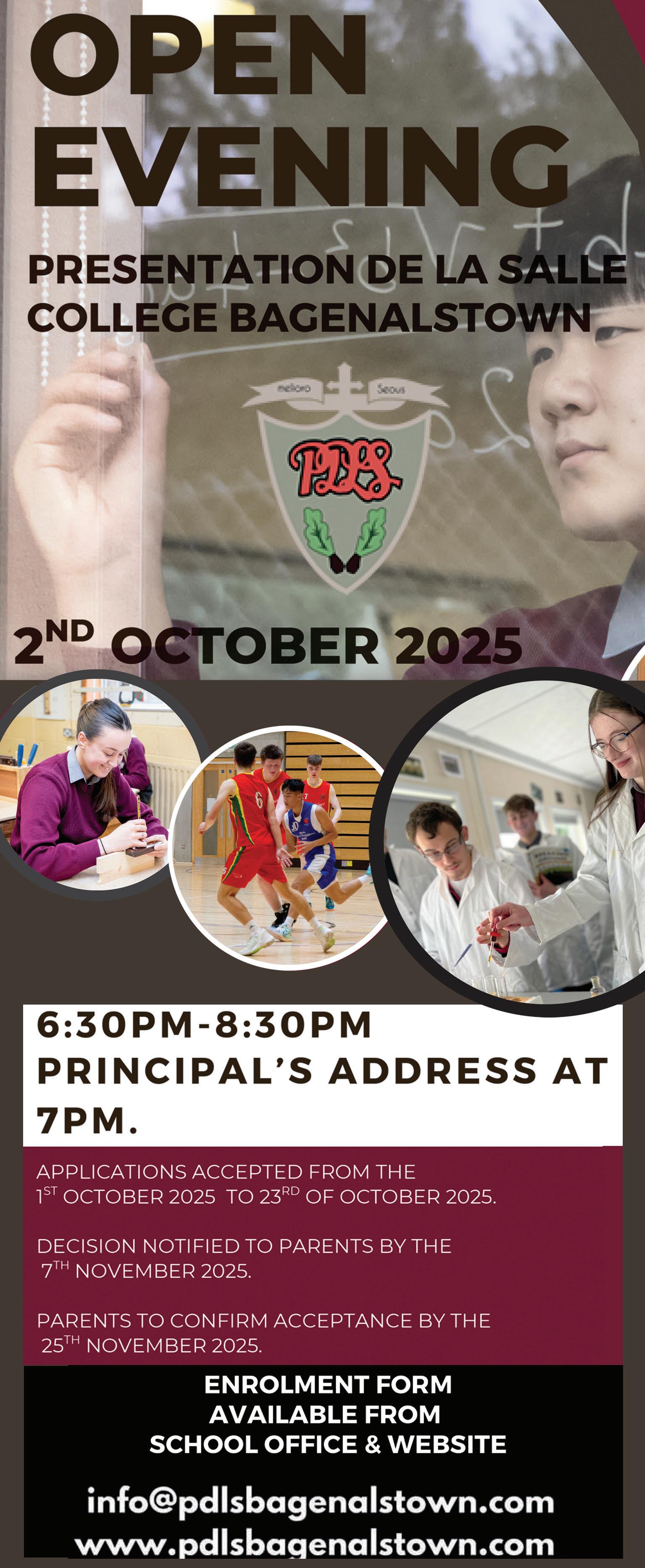

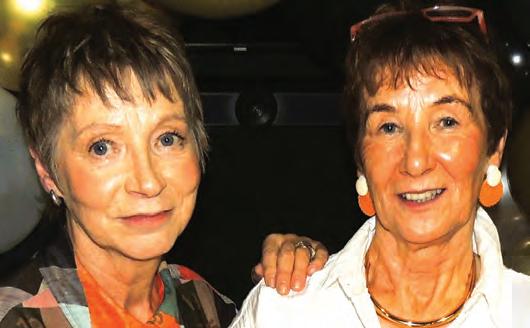



On Friday 12th September, a special occasion took place at the Pembroke Hotel, Patrick St., Kilkenny. It was a reunion of the Presentation Convent Inter-Cert and Leaving Cert class of 1973/75. Over fifty former school pals gathered for the festivities.
They travelled from America, Germany, Spain, England, Wales and various counties in Ireland to meet with their Kilkenny based ex schoolmates and as the saying goes, a great time was had by all.

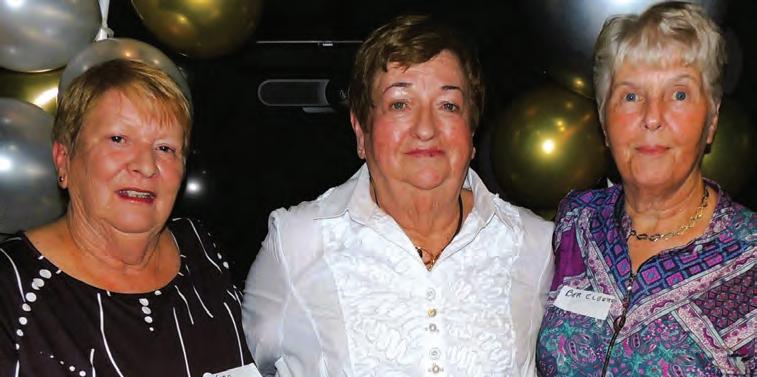







They reminisced about old times and the sound of chat and laughter filled the room. They also remembered school friends who have sadly passed away. Former teacher Cathal Cullen joined them for the celebration also. The committee thanked the Pembroke Hotel for the room and the wonderful food provided on the night. A big thanks also went to Don Devlin for putting together th e playlist of 70s music. The organising committee of Liz Murray, Sue Jordan, Etta Leahy, Caroline Hogan-Casey, Colette Cass-Byrne, Helen Devane and Ber Mooney said it was a special night and that it was wonderful to meet so many friends.










By Judith Ashton
Last week I wrote about kids fidgeting which led me to think how we can help them self -regulate so that they can calm down and learn to relax and relax to learn. I’m not just thinking here about small kids…this concerns teens as well and most of us adults too! All of us need to know about self-regulation so that despite living with so much stress in the world, we can stay grounded and regain our inner equilibrium whatever is going on around us. We can stay centred “in the eye of the storm!” I have spoken to about 20,000 kids in the last few years and so many of them have never been properly taught how to appropriately express their emotions. I know that so many people reach adulthood and are not emotionally literate. All people, every “physical” body, regardless of age, gender, colour or ability
have feelings….and as Freud pointed out most of these are learned responses, unconsciously laid down, before we are 4 years old. Many people are simply reactive when it comes to expressing themselves and we have a duty of care towards our kids to teach them effective communication skills and self- regulation as early as possible. Children need to know that we all have the whole range of feelings and that feelings come and go. Feelings are like clouds in the sky and they change all the time. Happiness comes and happiness goes. Anger rises and anger subsides. This is an unconditional truth. The reality. The way that it is. We can all feel happy one minute and sad the next and the most important thing to do with feelings is not to judge them, hang on to them or over identify with them, but to
talk about them, express them with movement or channel them in some way. The more kids can talk about them, channel or move with them, the less likely they are to get stuck in negative reactions. Kids can be taught to identify and then name their feelings by learning how to check in with their bodies. Does the body feel tight or tense? Is it a pleasant feeling like excitement or an uncomfortable one like fear? Is there a way we can encourage them to help the feeling /sensation move through the body by doing something expressive, like taking some deep breaths or stamping their feet? These are very simple ways for them to start a self-regulation practice. Movement and breathing practices are invaluable ways of helping the nervous system rebalance. These days many people find great benefits from yoga, t’ai chi, martial
arts, exercise, dance or sports. These disciplines are ancient and have numerous health benefits. Our modern medical science (which is only a couple of hundred years old) had arrogantly dismissed these approaches until relatively recently. We need to humbly learn from
“Support their emotions, and inner harmony will thrive
Ancient Wisdom cultures and traditions. They have so much to teach us.
Our Elders or so called, grandparents, if they have time and patience, can be great teachers. Self-regulation involves slowing down….. slowing the breathing and finding something calming to do.
We can help our struggling kids who are trying to navigate society’s complex demands by teaching them skills like yoga, meditation, how to enjoy a good book, building Lego or creating something, jigsaws, knitting, playing chess or a musical instrument etc. Anything that needs quiet focus, so definitely not screens which can over-stimulate the nervous system. As The Buddha said, “ Sit quietly and the grass grows by itself.”
Did you know, slowly swinging on a garden swing, in the fresh air has many


ed these talents to assist his parish and school, as
well as to create a nowfamous online catalogue of Eucharistic miracles and Marian apparitions. Active in parish life, Carlo
health benefits as it can slow both breathing and heart rates?
Whatever self-regulation practice someone can adopt from a young age will stand them in good stead for the rest of their lives. Everyone needs to learn self-regulation in order to be a well-balanced person who can communicate effectively. Such resources are essential life tools, vital for skilful communication within families, intimate relationships, friendships, at work and in the wider world of negotiations and politics. Talking about feelings and practising self- regulation are essential for positive mental health and self-esteem. Such skills enable us to cope in our world where good, truthful inter-personal, political and global communication is vital for all of us. Most important of all, they help us find peace and happiness in our lives.
served as a catechist and inspired many people to a deeper relationship with Christ. In 2006, he was diagnosed with acute promyelocytic leukaemia and died at just fifteen years old. Following his death, devotion to Carlo spread rapidly. His exhibitions on Eucharistic miracles have travelled worldwide, and pilgrims continue to visit his resting place in Assisi. In 2020, Carlo was beatified after a miracle in Brazil was attributed to his intercession. A second miracle in Italy was confirmed in 2024, and on 7 September 2025, Pope Francis canonised Carlo Acutis as a saint, together with Blessed Pier Giorgio Frassati. Often called the ’patron saint of the internet’, ‘God’s Influencer’, and the ‘first millennial saint’, Carlo’s life continues to inspire young people and families around the world.
The faithful and the wider community are warmly invited to attend this special mass at St. Canice’s Catholic Church and venerate the relic of Saint Carlo Acutis. St. Canice’s Parish Priest Fr. Willie Purcell commented “This is a great honour for our parish, as Saint Carlo Acutis is a witness of the goodness in young people and how they can use their talents and gifts to make our church and our world a better place.”


For more than 50 years, one institution in Castlecomer has remained at the centre of community banking, despite its long legacy, it couldn't be farther from the traditional members' cooperative of old. Today, it is a paragon of modern banking, forward-thinking and proactive, both in its range of financial services and support for its community.
The premises on Kilkenny Street is well-known to locals as the former O'Neill Chemist and Malone's Supermarket. If walls could talk, they would recall decades of service to the community, a tradition that Castlecomer Credit Union continues today.
CEO, Gerry Reynolds, told The
Kilkenny Observer what community means to him and the team at Castlecomer Credit Union, "We see ourselves as part of the community, here for the community today and for the generations coming after us. We're here to provide a service to our members. Not our customers, our members," he stresses.
Castlecomer Credit Union is a democratic financial cooperative owned and controlled by its members.
"The Credit Union belongs to the people," Reynolds continued, "It's owned by the members, run for the members, and everything we do is to benefit them. As a not-for-profit organisation, the money we make

Reynolds, CEO Castlecomer Credit Union

In response to its community's needs and the growing demand for sustainable living, the credit union introduced a suite of sustainable products, including competitive loans aimed at communities and large-scale projects. These loans are extended to community and business projects that are 100% green, in a commitment to boosting the local circular economy. Another initiative driven by members' feedback.
Recently, Castlecomer Credit Union introduced a Green Loan tailored for small-scale sustainability projects, offered at a highly competitive fixed rate of 7% over a minimum term of 10 years.
The facility was designed for households eager to transition to sustainable living, with funding available for 100% green initiatives, including solar panel installation, renewable energy systems, home retrofitting, and the purchase of electric vehicles.
The Green Loan reflects the Credit Union’s commitment to enabling members to make environmentally responsible choices while keeping costs affordable. Some members have reported significant benefits, including sharp reductions in household utility bills and, in some cases, credits resulting from solar generation and availability of battery storage. Others have highlighted the savings achieved through reduced fuel costs at the pump, a welcome relief amid the ongoing increase in the cost of living.

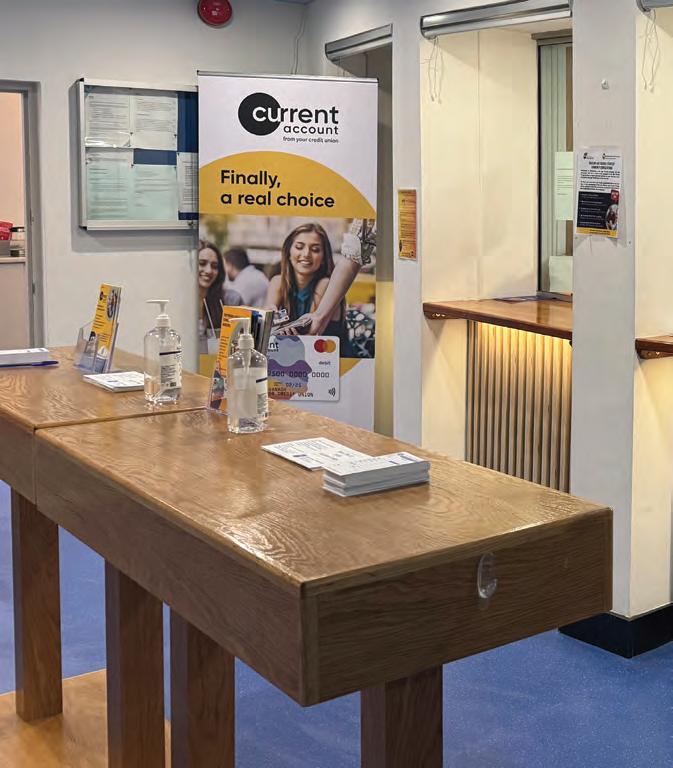
For the third consecutive year, credit unions have been recognised as the most reputable organisation in Ireland, topping the Ireland Reputation Index 2025.

The annual survey of 5,000 members of the public measures the level of trust, respect, admiration, and esteem that the public has for 100 of the largest and most essential organisations in Ireland.
The credit union ranked in first place for citizenship, conduct, and workplace, and also topped the poll when the public was surveyed about key indicators of trustworthiness. Credit unions were also perceived to be the most down-to-earth, fair, flexible, genuine, sincere, and straightforward organisation amongst the 100 household names studied.
A reputation that Castlecomer Credit Union embodies in its day-to-day activities. "If you have an issue, we're here. You can talk to us, and we will solve the issue there and then, rather than taking 45 minutes on the phone. No one has that kind of time to waste, and they often hang up the phone. The waiting time if you call the credit union is four minutes. That's our promise to our members. Usually, we can solve the matter in 45 seconds at the counter or on the phone," Reynolds explains.
Its reputation is well-earned, with exemplary customer care for over half a century of service in the community. Its legacy is evident in its careful archiving of important milestones from its first member, Mrs Dowling of Donaguile in 1967, to the 1,000th member, Mrs Catherine Keane, seven years later, and loans to cover the cost of a ticket to the local dinner dance in 1971.
Today, Castlecomer Credit Union has 6,200 members. Growing steadily from that first day on Saturday, 18th February 1967, when 34 members joined. It beckons the question; what would Mrs Keane or Mrs Dowling make of the advances in banking today?
Moving from ledger and ink to adopting technology in the late 1980s, the world of ICT and digital banking has moved quickly. Castlecomer Credit Union is committed to evolving with the current tech landscape, upgrading its communication equipment and computer systems as part of a recent refurbishment.
Reynolds said, "In the last six months, we have moved from land-based to cloud-based servers as we owe it to our members to offer technology that's as good as you'll find in any bank."
In response to its community's needs and the growing demand for sustainable living, the credit union introduces a suite of sustainable products, including competitive loans at 6.5 per cent to install solar panels or switch to electric vehicles. Sustainable loans are extended to community and business projects that are 100% green, in a commitment to boosting the local circular economy. Another initiative driven by members' feedback.




The Board of Management comprises nine voluntary members, three board oversight committee members, and two additional volunteers who give their time to a high-performing organisation that they own, along with the other members. These individuals draw on their own experience to guide the direction of the credit union and shape a future that serves the community's changing needs.
According to the CEO, "The idea of a credit union board is that you have a cross-section of local people to support the community. The volunteers put in a lot of work, and they don't even take expenses. Each one brings different experiences and values to the role. We rely on their guidance and input to advance our services and new initiatives.
We'd love for more people to come in and volunteer to help us, especially young people who can bring fresh ideas that represent the views of their peers. If people want to do something in the community, it is a rewarding experience."
There's only one quality required to be on the Board of Directors in a credit union, Reynolds tells us, "Common sense. That's all!"
Last year the Board approved over €25,000 in community projects, including Castlecomer Tidy Towns, Coon Tidy Towns and special schools projects. The Board is considering projects for various other groups and encourages organisations to reach out for support.”
Staying true to its ethos of looking to the future, the CEO went on to explain the credit union's plans to expand its services tailored to younger members and its innovative use of data analysis to grow its membership within the common bond area, approximately 30 kilometres from the town centre.
"There's a survey being conducted at the moment on our behalf, it's going to uncover rich data about the local population, we may find part of the common bond where we have no members, or the locale is underserved. Then we can target that area and say, ‘Look, we're here to help you’." Castlecomer Credit Union is performing very positively in 2025, with assets of €63 million, loans of €13 million, and a deposit of €47 million. Castlecomer Credit Union remains an independent Credit Union, offering the freedom and flexibility its members expect, but with the backing and access to resources of the Irish League of Credit Unions.
goes back into the community, either through dividends, interest rebates, or supporting local initiatives that benefit the wider area, such as Tidy Towns, local schools or community facilities.
Even the building we're sitting in reflects that. We didn't want to waste money, because it's the members' money. We made smart choices, reused what we could, and invested in making the space open, practical and useful," Reynolds explained.
Through the doors of the 19th-century building lies a contemporary interior of glass and smooth lines, sympathetically upgraded in 2022, in keeping with the fabric of the building and preserving many of its original features.
The echoes of time are still remnant throughout the property, yet clean and modern, filled with natural daylight, creating a pleasant work environment for the credit union staff and a comfortable, spacious place for members to conduct their banking.
A full range of banking services delivered locally
The credit union matches any financial institution for services, offering everything from current accounts and insurance to business loans and online banking.
True to its progressive business model, records show that Castlecomer Credit Union was one of the first branches in Ireland to introduce a current account to its range of services. The current account offers

members one convenient place to store their salary, manage their utilities or mortgage and access their funds easily from anywhere on the Globe.
Embracing contactless payments, current accounts are fully compatible with all modern payment methods, such as Apple Pay, Google Pay, and Fit Pay. With 24/7 support for lost or stolen cards, simply tap and go safely from anywhere across the globe. Members can keep track of their current account spending through the online banking portal or handy mobile app.
Unlike many commercial banks, a credit union current account can be set up within days, by simply walking into the branch for that personal faceto-face approach or via a short online application for time-poor people who prefer the convenience of setting it up at home or on the go.
Reynolds explains the process "is simple enough. You can press Enter at midnight, and at 12:01, it will be on our system. Four days later, you have your debit card." Account maintenance fees are fixed for transparency at just €5 per month.
Lending decisions are made by local people with the promise of a Friday turnaround, any loan requested through the dedicated loans officer is decided upon by the end of business by the following Friday.
It is evident that the credit union matches the commercial banking sector in every respect except for one. Its reputation for customer service.


Castlecomer Credit Union is delighted to be named a finalist in two categories at this year’s All Ireland Credit Union Awards, which will take place at the Crowne Plaza Hotel on 18th October. This recognition reflects the organisation’s commitment to supporting its members, staff, and the wider community.
The first nomination, the CU Community Award, celebrates credit unions that make an exceptional contribution to their local areas. Castlecomer Credit Union has been a cornerstone of the community for many years, backing schools, sports teams, charities, and social initiatives. From sponsoring youth activities to offering financial education and assisting vital local services, its staff work continuously to ensure residents benefit from meaningful support and opportunities.
Castlecomer Credit Union has also been shortlisted for the Healthy Workplace Award, which recognises employers that create a positive, inclusive, and health-focused environment. In recent years, the Credit Union has launched initiatives to enhance staff wellbeing, including flexible working options, team-building events, mental health awareness sessions, and wellness challenges. These measures reflect its belief that a motivated and healthy team delivers the best possible service to members. Earning a place among the finalists is a significant honour and highlights the dedication and teamwork that define Castlecomer Credit Union. Whatever the outcome on awards night, this achievement showcases its core values of community, care, and collaboration. Staff and members alike can take great pride in this well-deserved national recognition.
Growing together, powered by volunteers Your Credit Union needs you!
If you’re looking to save, borrow, volunteer, or simply bank with people who know your name, consider Castlecomer Credit Union, your community, your credit union. A confident and thriving business, future-facing, embracing innovation while staying true to its original values and growing in step with its members' evolving needs.

Castlecomer Credit Union has thrived for more than 50 years because of the dedication of local volunteers. Now we’re calling on the next generation to step forward. If you have spare time, energy, and ‘common sense’ and fresh ideas to share, join us and help shape the future of your community and your credit union.


Castlecomer Credit Union takes great pride in its town and surrounding areas, supporting projects that bring people together and strengthen community life
Castlecomer Credit Union takes great pride in its town and surrounding areas, supporting projects that bring people together and strengthen community life.
Castlecomer Credit Union was delighted to support Castlecomer Tidy Towns with a €5,000 contribution towards the purchase of a ride-on lawnmower, helping volunteers to keep the town looking its best and celebrating another step in enhancing the local environment.
Another organisation continuing its work in preserving and enhancing the character of the local area is Coon Tidy Towns and the Heritage Group, backed by the credit union, with a donation of €2,500 that recognises the lasting value it brings to the broader community.
Another example is the recently opened Muckalee Community Shop and Café, which has quickly become a vibrant hub for the area, regenerating rural Kilkenny and offering a welcoming space for people to connect, share common interests and support local volunteerism. Castlecomer Credit Union is proud to offer the committee €5,000 to support the ongoing initiative.
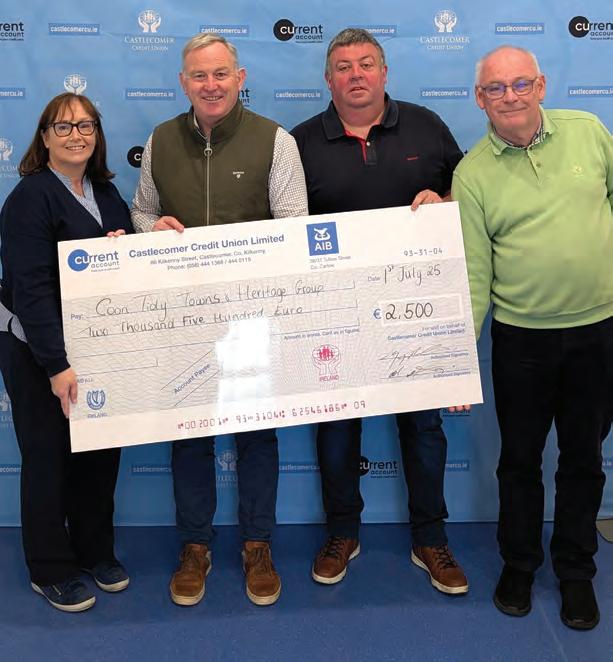

As Reynolds explains, “The money we make goes back into the community, either through dividends, interest rebates, or donations. Last year, we distributed approximately €25,000 in support, and this year

we have a healthy budget to continue helping local causes. We’re always interested to hear from our members about new projects that will benefit the community.” For more see: www.castlecomercu.ie



Understanding 3I/ATLAS
3I/ATLAS, officially designated C/2025 N1 ATLAS and initially labeled A11pl3Z, is the third confirmed interstellar object (ISO) to traverse our Solar System. The “3I” designation highlights its place as the third identified ISO, following the landmark discoveries of 1I/‘Oumuamua in 2017 and 2I/Borisov in 2019. Unlike conventional comets or asteroids, which are gravitationally bound to the Sun and follow elliptical or parabolic orbits, interstellar objects follow hyperbolic trajectories. This means they are not captured by the Sun’s gravity and instead pass through the Solar System at high velocities. These visitors originate from other star systems, giving astronomers an exceptional opportunity to study material formed under entirely different stellar conditions.
3I/ATLAS was discovered on 1 July 2025 by the Asteroid Terrestrial-impact Last Alert System (ATLAS) survey operating in Río Hurtado, Chile. At the time of discovery, it was about 4.5 astronomical units (AU) from the Sun, well beyond the orbit of Mars. Its hyperbolic orbit immediately confirmed its interstellar origin, as no gravitational pull from the Sun could retain it. Unlike conventional comets, which return repeatedly over centuries or millennia, 3I/ ATLAS is a transient visitor, allowing only a limited observation window before it exits our Solar System.
Detecting interstellar objects is notoriously challenging. Their high velocities and unpredictable paths make early detection crucial. Once discovered, astronomers have only a short timeframe to gather data before the object either approaches the Sun too closely—making observation difficult due to solar glare—or recedes beyond the reach of telescopes. The discovery of 3I/ATLAS, therefore, represents a rare scientific opportunity to study material originating in a distant stellar system.
Physical Properties and Observational Data Composition and Cometary Activity
A defining feature of 3I/ATLAS is its unusual chemical composition. Infrared observations using the James Webb Space Telescope (JWST) reveal that its coma—the diffuse cloud of gas and dust surrounding the nucleus—is dominated by carbon dioxide (CO₂). In addition, smaller quantities of water vapor (H₂O), carbon monoxide (CO), carbonyl sulfide (OCS), water ice, and dust are present. The ratio of CO₂ to H₂O is estimated at 8.0 ± 1.0, far exceeding the ratios observed in most Solar System comets at similar distances. This unusual composition suggests several possibilities: the nucleus may be intrinsi-

cally rich in CO₂; it could have formed near the CO₂ ice line of its parent protoplanetary disk; or environmental factors may be causing CO₂ to sublimate more efficiently than water during its inbound journey. The high CO₂ content provides insight into the chemical conditions and temperature profile of the star system in which 3I/ATLAS originated.
Water emission has also been detected through ultraviolet OH imaging by the Swift Observatory, even at a distance of 3.51 AU from the Sun. At such distances, water sublimation is typically minimal, but the presence of large icy grains in the coma enhances water vapor production. These observations indicate active cometary processes occurring far from the Sun and provide a unique perspective on how volatile ices behave under low solar irradiation.
Nucleus Size, Tail, and Brightness
Direct measurement of the nucleus is complicated by the bright, diffuse coma surrounding it. Estimates suggest the nucleus may range from hundreds of meters to a few kilometers, comparable to many Solar System comets, though precise measurements remain uncertain. The surrounding dust and gas influence apparent brightness and colour, complicating observation.
slow rotation, a near-spherical nucleus, or an activity level dominating over brightness changes caused by rotation.
Orbit and Trajectory
3I/ATLAS is on an inbound trajectory toward the Sun and is expected to reach perihelion—its closest point to the Sun—around 30 October 2025, at roughly 1.4 AU, inside Mars’ orbit. Its closest approach to Earth is estimated at 1.8 AU, posing no threat to our planet.
Due to its hyperbolic orbit, 3I/ATLAS will continue outward after perihelion, ultimately leaving the Solar System to return to interstellar space. Unlike bound comets, it will not remain in orbit around the Sun. This transient nature makes the observation window short but scientifically invaluable. During perihelion, Earth-based telescopes may lose sight temporarily due to solar glare, but visibility will return as the object emerges beyond the Sun.
Unique Features of 3I/ATLAS
Several characteristics make 3I/ATLAS a particularly compelling target for scientific study.
cantly different from those in our Solar System, offering insight into chemical processes within distant protoplanetary disks.
Activity at Large Distances; Observing CO₂ and water outgassing at distances greater than 3 AU is unusual and valuable. It allows scientists to study how volatiles behave under minimal solar heating, challenging existing models of comet activity. The presence of large icy grains contributes to water vapor production and may reveal novel sublimation dynamics not seen in typical Solar System comets.
Colour and Dust Evolution; Tracking changes in spectral colour and brightness provides insight into the evolution of dust and ice in the coma. Reddened dust indicates older, processed material, whereas a neutral or solar-like colour signals freshly exposed icy grains. These observations help astronomers understand surface layering, sublimation processes, and the interplay between dust and volatile outgassing.
troscopy identifies molecules like CO, CO₂, and H₂O, enabling scientists to model the comet’s thermal history and formation environment.
Perihelion presents a critical observation window, when solar heating will intensify cometary activity. Monitoring changes in tail morphology, outgassing rates, and potential fragmentation provides unprecedented insights into the behavior of interstellar comets under solar influence.
Post-perihelion observations allow scientists to study longterm effects of sublimation, radiation, and dust dispersal as 3I/ATLAS recedes into interstellar space.
Open Questions and Challenges
Despite extensive monitoring, several key questions remain:
Nucleus Size and Shape: The bright coma obscures the nucleus, complicating rotation and dimension measurements. Volatile Inventory: While CO₂ dominates, the interior composition and isotopic ratios relative to Solar System comets remain uncertain.
mation in different environments. Protoplanetary Disk Conditions: High CO₂ content may indicate specific temperature, radiation, and chemical conditions in its original disk. Interstellar Object Populations: Every new ISO improves statistical understanding of how many such objects exist and their typical properties. Evolution of Cometary Activity: Monitoring activity at varying distances informs models of volatile behavior, dust dynamics, and tail formation. Public Engagement and Technology: Discoveries like 3I/ATLAS capture public interest, encourage survey improvements, and foster rapid-response observation networks.
As of late 2025, 3I/ATLAS is actively monitored by a range of observatories. It will reach perihelion on 30 October 2025, then continue outward into interstellar space. Earthbased visibility will fluctuate depending on its position relative to the Sun, with temporary periods when observation is hindered by solar glare. Over the coming months, astronomers will track changes in coma brightness, tail morphology, and volatile emissions. Any outbursts or fragmentation events will provide critical data on the structural integrity of interstellar comets. Long-term, 3I/ATLAS will be compared with prior ISOs like ‘Oumuamua and Borisov, helping establish a broader framework for understanding these rare visitors. These observations may influence future survey strategies, early detection methods, and the conceptual planning of potential space missions targeting ISOs.
Studying 3I/ATLAS provides insights beyond a single comet. It illuminates the formation and evolution of planetary systems beyond our Solar System, the diversity of interstellar materials, and the fundamental processes shaping cometary bodies throughout the galaxy. As this small interstellar visitor passes through our Solar System, it carries with it a story from another star, enriching our understanding of the cosmos and highlighting the interconnectedness of astronomy, planetary science, and astrophysics. C/2025
Photometric monitoring by ATLAS and other groundbased telescopes has revealed changes in colour over time. Initially, 3I/ATLAS appeared reddish, likely due to dustrich surface material. As it approached the Sun and cometary activity increased, its colour shifted toward a more neutral, solar-like hue, reflecting the production of fresh icy grains in the coma. Interestingly, no significant brightness variations have been observed, which could indicate a
Rarity of Interstellar Objects; With only two previously confirmed ISOs—1I/‘Oumuamua and 2I/Borisov—3I/ATLAS provides an essential additional data point for understanding material from other star systems. Each ISO exhibits unique properties, and comparing their chemical composition, trajectories, and activity patterns allows astronomers to investigate the diversity of planetary system formation across the galaxy. CO₂-Dominated Coma; Unlike most Solar System comets, which are primarily waterdriven, 3I/ATLAS exhibits a coma dominated by CO₂. This unusual composition may indicate formation under environmental conditions signifi-
Interstellar Insights; As an object formed in another star system, 3I/ATLAS carries material from a completely different protoplanetary environment. Studying its isotopic ratios, volatile composition, and dust content may reveal the diversity of planetary systems and the prevalence of certain chemical mixtures outside the Solar System.
Observational Campaigns; Astronomers are employing a multi-pronged observational strategy to study 3I/ATLAS: JWST observes the coma in infrared, detecting CO₂, H₂O, dust, and structural features. Swift Observatory monitors ultraviolet OH emissions, tracking water outgassing at large solar distances. Groundbased telescopes such as ATLAS and SOAR follow photometric changes, colour evolution, tail formation, and variations in activity. Spec-
Temporal Evolution: How will outgassing and dust production change as the comet approaches and recedes from the Sun? Formation Origins: From what type of stellar system did 3I/ATLAS originate, and at what distance from its star did it form? Detection
Bias: Are interstellar comets truly rare, or have prior surveys failed to detect them?
Solar Effects: How will radiation, tidal forces, and sublimation near perihelion affect the nucleus? Could outbursts or fragmentation occur?
Implications for Astronomy and Planetary Science
3I/ATLAS has broad implications across multiple scientific areas: Comparative Comet Chemistry: Its composition provides a basis to compare with Solar System comets, testing models of comet for-
3I/ATLAS is a rare and scientifically invaluable interstellar visitor. Its CO₂-rich composition, activity at large distances, hyperbolic trajectory, and evolving colour and brightness make it one of the most important interstellar objects discovered to date. While questions remain regarding its size, rotation, interior composition, and formation history, ongoing observation campaigns are rapidly expanding our knowledge.


The HSE’s Autumn/ Winter covid-19 vaccination drive begins this October in local pharmacies.
As the nights draw in and the weather turns cooler, autumn is the perfect time to give your health a seasonal boost. Shorter days, cooler temperatures and reduced sunlight can affect energy, mood and even immunity - but small adjustments can make a big difference. Nutrition is key. Seasonal fruits and vegetables like pumpkins, squash, apples, pears, carrots and leafy greens provide vitamins, minerals and antioxidants. These nutrients support immunity
and overall wellbeing while adding flavour and variety to meals. Include whole grains, legumes, nuts and seeds to maintain energy and digestive health. Soups, stews and roasted vegetables make nutritious comfort food that’s easy to prepare at home. Movement is essential. Even with colder weather, regular activity improves circulation, lifts mood and strengthens muscles. Walks in local parks, along Kilkenny’s country lanes or simple indoor exercises at home can be highly effective. Stretching, yoga or light resistance training also
helps maintain flexibility and joint health, which becomes increasingly important as the weather turns. Self-care matters. Autumn is an excellent time to reassess your routines and prioritise mental wellbeing. Adequate sleep, stress management and moments of relaxation support both physical and emotional health. Gentle stretching, meditation or even journaling can reduce anxiety, while warm baths, herbal teas or cosy reading nooks help you unwind. Skincare and hydration shouldn’t be neglected.
air and central
dry out
and SPF
important - even on cloudy days. Drinking plenty of water and incorporating hydrating foods like soups and fruits helps maintain healthy skin. Autumn offers an opportunity to strengthen immunity, improve mood and set routines that carry into winter. By focusing on nutrition, movement, self-care and hydration, you can stay fit and resilient throughout the colder months. Small, consistent steps now will pay off in long-term health and wellbeing.
How to care for your skin the eco-friendly way
In recent years, natural and eco-friendly skincare have become so much more popular- and for good reason. We are increasingly looking for products that are kind to both our skin and the environment, free from harsh chemicals and sustainably produced. Many plant-based ingredients, like aloe vera, chamomile and green tea extract, have proven soothing and antioxidant properties. They help calm irritation, protect against free radicals and support healthy skin barrier function. Essential oils can provide subtle fragrance and therapeutic benefits, but it’s important to patch-test to avoid reactions.
Beyond what’s in the bottle, how products are packaged is
increasingly important. Glass jars, recyclable plastics and biodegradable containers reduce environmental impact. Brands that refill containers or offer concentrates are also leading the way in responsible beauty.
Switching to natural doesn’t mean compromising results. Cleansing, moisturising and sun protection remain essential. Gentle cleansers preserve natural oils, while moisturisers enriched with botanical oils or shea butter keep skin supple. Natural sunscreens protect without harsh chemicals and products like mineral powders offer coverage without clogging pores.
For those who want complete control, simple ingredients from the kitchen can double as effective skincare.

Oatmeal masks, honey cleansers and avocado-based moisturisers are gentle, nourishing and often budget-friendly. Natural beauty combines health-conscious choices
with environmental awareness. Even small changes, like switching a few products or checking labels, make a difference - for your skin, for your wellbeing and for the planet.
Protection is strongly advised for everyone aged 60+, people with chronic health conditions, those with weakened immune

systems and residents in long-term care. Healthcare staff and pregnant women in these groups are also urged to get vaccinated. You should wait at least three months after your last dose or infection. A quick jab now could save you from serious illness this winter.
Niya Yoga Studio, Thomastown - Personalised classes and drop-ins that improve posture, balance and inner calm.
TJ Reid Health & Fitness, Kilkenny - 15,000 sq ft facility with state-of-the-art gym, Disco Spin, strength & conditioning area and 40+ high-energy classes for all levels.
Ormonde Leisure Club, Kilkenny - City-centre gym and pool offering Spin, HIIT, Aqua Fit and Abs Blast classes for all levels.
The Factory Fitness & Nutrition, Kilkenny - Personalised workouts and nutrition plans to help you move better, get stronger and stay pain-free.



BY JOHN FITZGERALD

St Canice’s Mental Hospital in Kilkenny closed its doors in 2006, drawing down the curtain on a long history of care for those afflicted by a range of non-physical illnesses. Former residents, and their relatives and loved ones, have mixed memories of the institution.
Treatment of the mentally ill has evolved through the decades, but at the time this building opened, the life of any person thus afflicted could be a grim one indeed. People often suffered unnecessarily due to a lack of understanding of mental illness, on the part of both the medical profession and wider society.
I accompanied the Kilkenny Heritage Walkers on a visit to the old St. Canice’s hospital building recently.
Before the talk began, we had to seek shelter under the expansive canopy of a tree when the suitably grey sky unleashed a downpour. The weather was in keeping with the sombre atmosphere of the site. Through a squally haze, historian Paddy Neary relayed the story of St. Canice’s.
As he spoke, umbrellas sprang open. A group of ramblers and a dog walker with his lurcher raced for cover, scattering autumn leaves in their wake.
Paddy told the story without frills. He let the listener draw his or her own conclusions, and reflect on a part of our history often overlooked or ignored.
The creation of the institution that would later become known as St Canice’s, he explained, commenced in 1848, and was designed to cater for 150 inmates. It was part of a series of publicly funded asylums erected under the auspices of the Board of Works. The estimated cost was £21,500.
It opened in 1852 as Kilkenny District Lunatic Asylum. The name today shocks many people, then but there’s a world of difference between attitudes back then and our present way of thinking.
Paddy recalled that the first person admitted to the asylum was a 70-year-old woman. She was one of more than fifty people transferred from the Carlow District Hospital for the Insane. She lived for seven years at the Kilkenny asylum before dying, according to hospital records, of “natural causes.”
A further forty-seven people

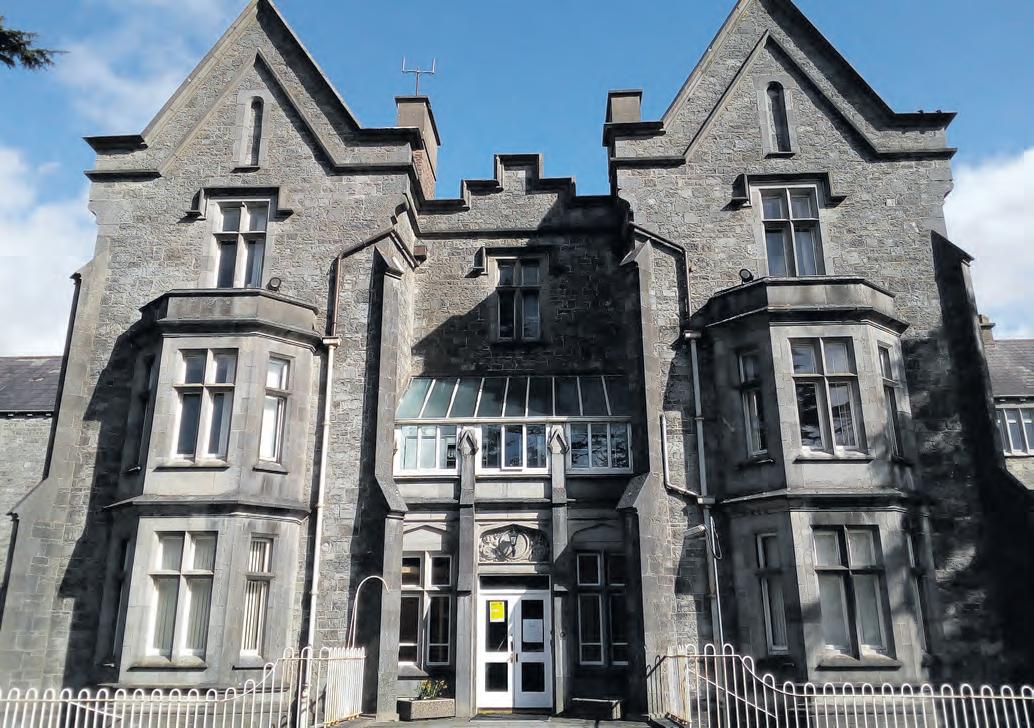
arrived on official opening day from the Kilkenny Lunatic Asylum, which called itself a “a small house of correction”, from the county prison, and ten others from the general district.
The first Resident Doctor at the hospital, Dr Joseph Lalor, found significant challenges in his management of the institution. He complained that attendants lacked sufficient experience, and that the building itself had not been completed. He also found that water supply was both inadequate for the number of inmates and impure. He was concerned too about storm damage to parts of the building
By the first winter after its opening, work had commenced on the addition of a farm and garden to the asylum, amenities deemed essential to keeping the inmates active. Such work was beneficial to their
each inmate was about £18 per year. Meals were, by the standard of the times, reasonable and nourishing. A portion of oatmeal, rice and new milk, for breakfast, with bread and milk for dinners on some days, and beef, peas and soup on other days of the week, with whatever vegetables happened to be in season.
Despite the stigma attaching to mental illness, the institution had to turn away many applicants or referrals; such was the demand for its services. From 1868, even more people sought to gain access to the hospital after a new Act of Parliament allowed direct admissions by certain categories of people without the necessity of having to serve jail time first, as previously required.
water supply.
It was in the 1950s that the asylum came to be known as St Canice’s Mental Hospital- a welcome change from its former Victorian title, in keeping with changing times and attitudes, but a far greater change for the institution came in 1980 with the advent of community-based rehabilitation. The patient numbers dropped drastically. In later years, the opening of a psychiatric unit at St. Luke’s Hospital saw a further decline in the traditional role of St. Canice’s and in 2006, the old building finally fell silent.
to have a statue installed on the grounds of the hospital. This offered great solace and spiritual comfort to patients and staff alike. Thousands knelt at the grotto to pray to the Mother of God.

The occupations of those entering the institution were diverse. Among those listed for the second part of the 19th century are labourers, colliers, fiddlers, hat makers, fruit sellers, dyers, farmers, tailors, and publicans. The hospital also recorded the education level of inmates.
four and twelve
The numbers at the hospital continued to grow and by 1902, it had 440 patients. To accommodate the increasing demand for space Lacken House opened in 1906 (Lacken operated until the 1960s when a fire engulfed the building.)
By 1939, the institution had its own farm, with pigs, cattle and vegetables. It also had workshops with a range of skills and needs catered for… tailoring, shoemaking, and painting among them. It had two churches, a laundry, a boiler house and an adequate
The treatment of mental illness had come a long way since that day in 1852 when the 70-year-old woman from the Carlow District Hospital for the insane stepped through the high creaking doors of Kilkenny District Lunatic Asylum.
By the time that Paddy Neary concluded his lengthy presentation, the rain had abated, but a light drizzle persisted. The old building looked greyer and bleaker through the silvery droplets that a breeze fanned across the extensive lawn. It took on a mantle of sadness and quiet despair…faintly echoing its institutional past.
Paddy handed the microphone to Marianne Kelly who recounted the story of the Marian Shrine at St. Canice’s. This stands on the lawn directly opposite the main entrance to the building.
We crossed the lawn to view the impeccably- kept grotto. Marianne recalled that in 1954, members of nursing and other staff at St. Canice’s banded together
Prior to 2014, people left coins of all denominations on a pier at the grotto, some to ask favours of Our Lady, and others in thanksgiving for favours granted. For years patients, staff and visitors prayed at the secluded spot. It was a true oasis of peace in a troubled world. But in 2014 disaster struck. A raging storm uprooted a tree that fell on the grotto, knocking over and badly damaging the statue. Marianne and others networked and lobbied, and to the rescue came noted monumental sculptor, Pat Murphy of Callan. He had the statue repaired and restored to the grotto in September of that year, a day of immense relief and celebration for the people of Kilkenny. In the past, patients and staff had looked after the maintenance of the grotto. Today, the HSE has taken over that delicate and noble duty, and the shrine continues to attract visitors.
The Heritage Walkers and those who had joined them for the talk at St. Canice’s thanked Paddy Neary and Marianne Kelly for another thoughtful journey back in time. They also commended Marianne for her meticulous research into the origins of the Marian statues of Kilkenny. Writer/journalist Jimmy Rhatigan also cites her project in his book on exceptional achievers in the county.